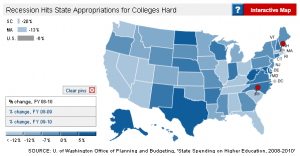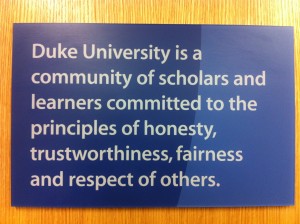Change Rewards, Change Leadership
 A few nights ago, at a meeting of IT people from a subset of research universities, dinner conversation turned to why IT people work in higher education. If you do IT in higher education, everyone pretty much agreed, it’s not to get rich. Rather, you’re driven by some combination of four reasons.
A few nights ago, at a meeting of IT people from a subset of research universities, dinner conversation turned to why IT people work in higher education. If you do IT in higher education, everyone pretty much agreed, it’s not to get rich. Rather, you’re driven by some combination of four reasons.
- IT jobs in higher education have tended to entail a complicated, challenging, and rewarding set of challenges. IT organizations in colleges and universities tend to be relatively small, and tend to involve teamwork across domains that might otherwise be separate. There’s not the neat division between, say, technical and support staff that one might find elsewhere, and so there has been ample opportunity to grow along various dimensions.
- IT jobs in higher education have generally involved a certain amount of flexibility. One spends most of one’s time on one’s job, but it’s been commonplace for a certain fraction of time – perhaps as much as 20% — to be essentially the staffer’s to allocate. Much of that time has gone to experimenting with new technologies, or ways to use old technologies, or even to thinking about things not strictly technological. In the aggregate, much of that “uncommitted” time has gone to innovation, some successful and some not. But the opportunity to spend time on activities that are not strictly part of job descriptions, with part of that involving experimentation and innovation, has enabled IT organizations in higher education to be sources of administrative, educational, research, and technological progress.
- IT in higher education has usually provided good job security. Absent failure to produce or malfeasance, IT staff in education could reasonably assume that they would have jobs so long as they continued to perform well.
- This one’s somewhat different from the other three reasons. IT jobs in higher education have been an interesting and useful way station for recent graduates with abundant energy and skill but little sense of career or personal-development paths. For many IT staff, the job is not an end in itself, but rather a reasonable way to work for a few years while figuring out what to do next – be that graduate school, marriage and family, relocation, a more remunerative job, or whatever. That is, part of what appeals is working where one recently got – or is soon getting – a degree.
For reasons good and bad, the reasons to work in higher-education IT work have eroded, without commensurate offsets such as better pay. This has had little effect on those who work in higher-education IT for reason #4. So long as economic downturns have affected the corporate and .com worlds more than colleges and universities, it also has had little effect on those who work for #1-3. Since the economy has been on a bit of a roller coaster for some years, we’ve thus seen little erosion of IT staffing in higher education.
 But as financial strictures settle firmly into higher education, this is changing. There have been greater compartmentalization of tasks, tighter accounting for time and effort, and layoffs unrelated to performance. These directly undercut reasons #1 through #3 for working in higher-education IT, and they’re beginning to have effects on staffing.
But as financial strictures settle firmly into higher education, this is changing. There have been greater compartmentalization of tasks, tighter accounting for time and effort, and layoffs unrelated to performance. These directly undercut reasons #1 through #3 for working in higher-education IT, and they’re beginning to have effects on staffing.
What many perceive is a key shift in the higher-education IT workforce: fewer young staff stick around to rise through the ranks, and loss rates do not reverse with age as they once did. The staff-by-age distribution is becoming bimodal, and whereas the left-hand mode is staying put or moving left – that is, staff who leave are leaving sooner – the right-hand mode, starved for replenishment from the middle, is moving right. As a result, higher-education IT organizations are increasingly starved for middle management, and as a second-order consequence they are decreasingly able to fill leadership positions from within. We therefore see more middle-management and leadership hires from the corporate sector.
Those new hires, unaccustomed to reasons #1-4, are likely to magnify rather than counteract the changes that underlay their hiring. The result, if we can avoid a vicious circle, is that non-pecuniary reasons for working in higher-education IT will give way to pecuniary ones. IT staff in colleges and universities will have more focused, less flexible, and less secure jobs, but they will be paid more to do them. If productivity under the new regime grows sufficiently to offset higher IT payrolls (which may mean that staffing levels decline), then the evolution can succeed. If it doesn’t, then increased spending will fail to yield commensurate progress.
Let’s assume, for the moment, that the evolution is both desirable and successful. What issues might we need to address? Here are five for starters:
 Whether we like it or not, colleges and universities operate with cultures that are very different from corporate cultures. If staff are hired from the latter, then we need to find effective ways to quickly give them an understanding of the former. This doesn’t mean that outside hires must go native, accepting their new culture as gospel, but rather than they must understand the status quo if they are to change it.
Whether we like it or not, colleges and universities operate with cultures that are very different from corporate cultures. If staff are hired from the latter, then we need to find effective ways to quickly give them an understanding of the former. This doesn’t mean that outside hires must go native, accepting their new culture as gospel, but rather than they must understand the status quo if they are to change it.- If pay does become a dominant reason for people to work in higher-education IT, then colleges and universities must adopt modern approaches to compensation: bonuses for effective work, putting some compensation formally at risk, direct connections between performance reviews and compensation, benefits suited to staff needs, and most important compensation levels that truly compare favorably with the outside market.
- Even if we successfully integrate and compensate staff from outside higher education, inevitably staff turnover will be higher than it has been in the past: that’s another attribute of corporate IT cultures. This means that college and university IT organizations can no longer rely on long-term employees as the repositories of accumulated experience. Rather, they must adopt formal mechanisms for reaching, making, and recording decisions, for documenting implementation and change, and generally for ensuring that wisdom survives turnover.
- Idiosyncrasy, long the hallmark of higher-education IT and in many cases the guarantor of continued employment, will give way to standardization. The default for decisions whether to outsource will no longer be “no”. The burden of proof will shift to those opposing outsourcing, and there will be increased scrutiny of “we’ve always done it this way” arguments.
- Partly as a result of #4, possibilities for inter-institutional collaboration and joint procurement should expand. In some cases this will lead logically to joint-development efforts, especially where higher education has unique needs (for example, student systems, learning-management systems, and many research applications). In other cases it will lead logically to demand aggregation, especially where higher-education needs are consistent, they resemble those outside the academy, and they yield no competitive advantage (for example, email systems or cloud-based storage).
 Many of those currently preparing to become leaders within higher-education IT are ill prepared to address issues like these. Many of those who come from outside to take leadership positions in higher-education IT do not understand why issues like these are hard to address in higher education. The solution, as with many of the changes we face, is serious, deep-thinking professional development: places where those rising or jumping into college or university IT leadership can learn what the future is bringing and how to address it. These can be didactic, like EDUCAUSE’s management and leadership institutes, or collaborative, like the Common Solutions Group, the Council of Liberal Arts Colleges, the League for Innovation, and other entities where peers gather to share experiences and best practices.
Many of those currently preparing to become leaders within higher-education IT are ill prepared to address issues like these. Many of those who come from outside to take leadership positions in higher-education IT do not understand why issues like these are hard to address in higher education. The solution, as with many of the changes we face, is serious, deep-thinking professional development: places where those rising or jumping into college or university IT leadership can learn what the future is bringing and how to address it. These can be didactic, like EDUCAUSE’s management and leadership institutes, or collaborative, like the Common Solutions Group, the Council of Liberal Arts Colleges, the League for Innovation, and other entities where peers gather to share experiences and best practices.
In the past we’ve built leaders informally, by drawing them from those who have been with us for a long time. As that pool dries up, we need to think differently.
[…] This post was mentioned on Twitter by Grace Simrall. Grace Simrall said: RT @jgackson Change Rewards, Change Leadership http://bit.ly/hln3Cc insightful ruminations on IT in higher ed #in […]
January 14th, 2011 at 12:07 pm